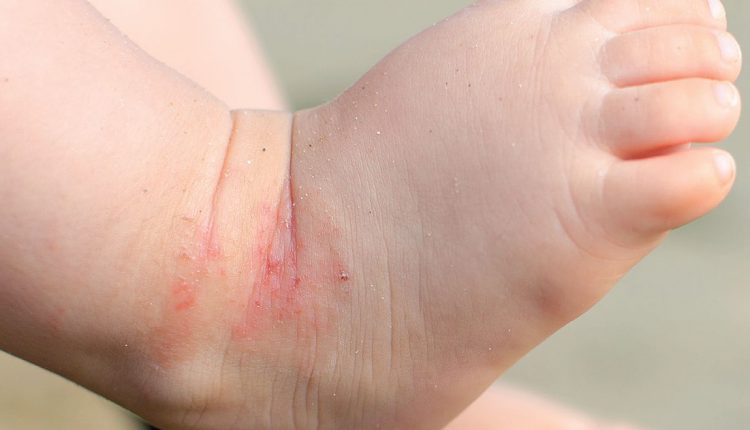
Childhood psoriasis: what it is, what the symptoms are and how to treat it
Infantile psoriasis is a chronic and generally asymptomatic inflammatory disease of the skin, joints and nails
Childhood psoriasis is a chronic inflammatory disease affecting the skin, nails and sometimes the joints
The frequency is estimated at around 3%, with a variability ranging from 1 to 8.5%.
In paediatrics, psoriasis is underestimated because some cases with minimal or atypical skin manifestations go undiagnosed.
Psoriasis is manifested by round, sharp-edged, reddish patches typically covered with whitish scales that are usually not itchy.
The number of patches varies and may even affect the entire skin surface.
The most classic form is characterised by involvement of the extensor surfaces of the limbs, particularly the elbows and knees, and the lumbosacral region.
In addition to this form, there are other clinical variants more characteristic of the paediatric age. In all these forms, the scalp and nails are often involved.
On the scalp there is intense desquamation, while the nails have a characteristic spotted appearance (“pitting”), and tend to thicken and take on a yellowish colour.
CHILD HEALTH: LEARN MORE ABOUT MEDICHILD BY VISITING THE BOOTH AT EMERGENCY EXPO
What causes childhood psoriasis?
At the moment it can be considered a multifactorial disease, with an underlying genetic alteration and triggering factors.
These include mechanical trauma such as rubbing, coexistence with other diseases (co-morbidities such as obesity, dyslipidaemia), infections of the oro-pharynx, emotional and climatic factors and certain medications.
Sometimes it is not possible to recognise the underlying cause.
Research has shown that the cause of psoriatic lesions is an immunological alteration of the skin that is not yet well identified and an increased turnover of the superficial layers of the skin.
In infants the common seborrheic dermatitis (commonly called crusta lattea) characterised by the presence of yellowish scales on some areas of the face and scalp can sometimes be a warning sign in children with a family history of psoriasis.
In these cases the evolution of the dermatitis will confirm or not the diagnosis.
Psoriasis, what are the common paediatric forms?
The typical forms of psoriasis in children are:
- Napkin psoriasis: characteristic of infants in which psoriasis occurs in the nappy area with bright red, shiny lesions with clear-cut margins, also affecting the folds. In this form scales are often absent, due to the effect of moisture created by the nappy; in this form there is also often umbilical and nail involvement;
- Inverse psoriasis: in which the flexural folds such as the armpits, groin, genital area and umbilicus are affected. In this case the lesions are intensely reddened and there are no scales;
- Psoriasis guttata: characterised by the eruptive appearance of small patches of a few mm to about 1-2 cm in diameter, sometimes very numerous, distributed all over the body, mainly on the trunk. Sometimes this form can occur following pharyngitis, tonsillitis or bacterial otitis. Blood tests and possibly a pharyngeal swab and an ENT examination should be carried out to look for any foci of infection that need to be eradicated.
Furthermore, in children, psoriasis may be limited to minimal forms with localisation limited to the eyelids with erythematous (red) patches with clear-cut margins and sometimes covered with fine scales.
The other skin forms described in adults and psoriatic arthropathy are exceptional in children.
Symptoms and prognosis of childhood psoriasis
Psoriasis, apart from the cutaneous manifestations, is generally asymptomatic, only in some cases, related to the site of the manifestations such as folds, or to the character of the patient itching may be complained of.
It tends to be a chronic disease with a relapsing course.
The remission of the skin lesions is temporary for a variable period, but it is possible, especially in children, that they do not recur for life.
In fact, lesions in children are less resistant to treatment.
However, the genetic alteration underlying the disease is irreversible and therefore there remains a predisposition to the disease that could recur at any time in life.
Treatment of childhood psoriasis:
Treatment, as forms in children are often mild, is only local.
Creams containing cortisone, calcipotriol (a derivative of vitamin D), tazarotene, vegetable tar, and non-steroidal anti-inflammatory drugs are used.
When the inflammation is severe, the drug of first choice is local cortisone, but the doctor’s instructions must be followed.
Emollient and moisturising creams are widely used.
In scaly lesions and only in older children, keratolytic creams are recommended, i.e. creams capable of detaching the scales and favouring their elimination, such as those containing salicylic acid, urea, mixtures of alpha and beta hydroxy acids.
In particularly widespread forms heliotherapy (exposure to the sun) may be useful, although it should not be forgotten that excessive and inadequate exposure to ultraviolet rays is extremely harmful even in children.
For this reason, the same precautions should be observed as for healthy children.
Treatment with ultraviolet lamps should be avoided in children, even in the winter months, so as not to subject the child to an excessive – and therefore harmful – cumulative dose of radiation.
In severe, very extensive forms that are resistant to adequately applied topical therapies, or in sensitive areas with a significant psychological impact, systemic therapies based on biological drugs can be carried out, some of which are now also approved for paediatric use.
However, the treatment must always be proposed by the treating dermatologist and the child must be regularly monitored to exclude side effects.
Finally, in children with other concomitant pathologies, efforts should be made to treat this pathology.
Read Also:
Emergency Live Even More…Live: Download The New Free App Of Your Newspaper For IOS And Android
Epidermolysis Bullosa And Skin Cancers: Diagnosis And Treatment
SkinNeutrAll®: Checkmate For Skin-Damaging And Flammable Substances
Healing Wounds And Perfusion Oximeter, New Skin-Like Sensor Can Map Blood-Oxygen Levels
Psoriasis, An Ageless Skin Disease
Psoriasis: It Gets Worse In Winter, But It’s Not Just The Cold That’s To Blame



